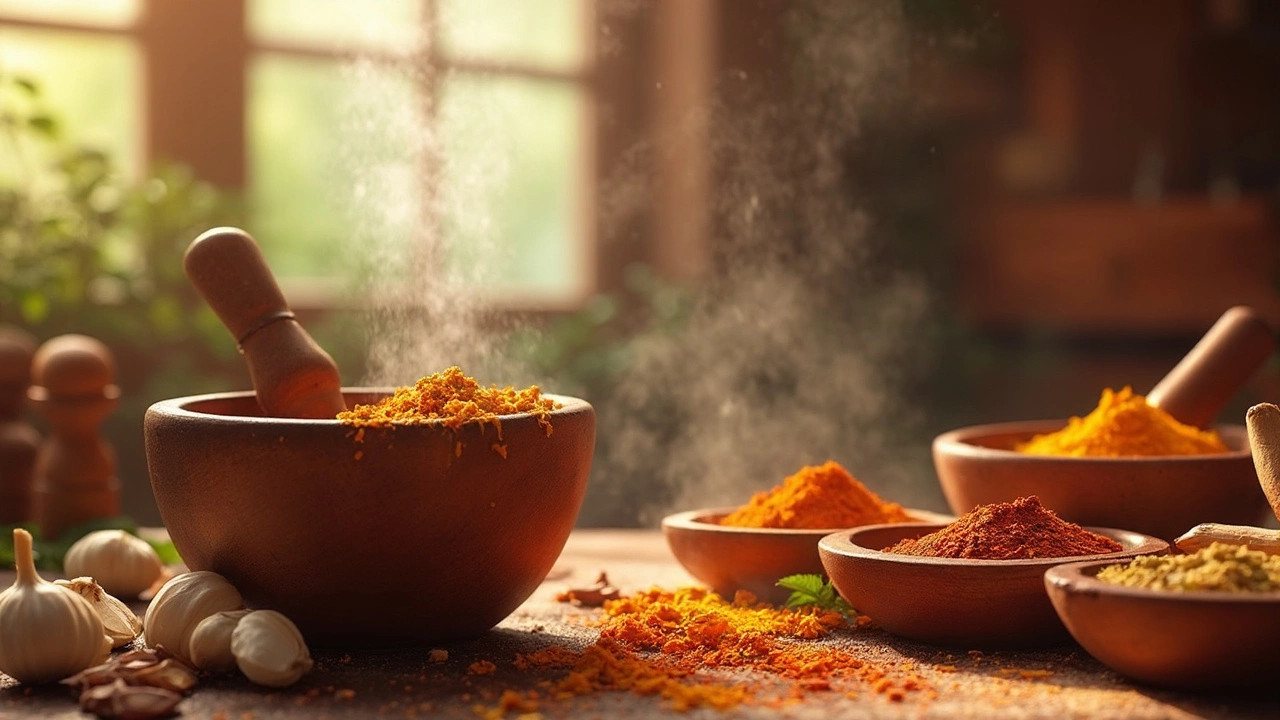So, your chutney tastes like a garlic bomb went off? Don't worry, you're not alone. Garlic is one of those love-it-or-hate-it ingredients, and it's all too easy for its potent flavor to hog the spotlight in your dish. But no worries, there are a few tricks you can try to tone down that garlic gusto and get your chutney back to a harmonious balance.
First up, think about acidity. Adding an acidic element like lemon juice or vinegar might help to cut through that strong garlic taste. It's not just about masking the flavor, but also balancing it. A little splash might do the trick without disrupting the other flavors.
- Understanding Garlic in Chutney
- Signs of Overpowering Garlic Taste
- Balancing Flavors with Acidity
- Using Sweetness to Tone Down Garlic
- Incorporating Dairy for a Mellow Profile
- Prevention Tips for Future Batches
Understanding Garlic in Chutney
Garlic can be a delicious addition, but when it comes to chutney recipes, it's all about balance. Garlic is one of those ingredients that folks either love or avoid like the plague. It has a pungent aroma and flavor, which, if not used carefully, can overshadow other ingredients.
Originally hailing from Central Asia, garlic has been a staple in cooking for thousands of years. It's known for its health benefits, like boosting the immune system and even lowering blood pressure. It's no wonder it finds its way into many culinary creations, including chutneys.
How Garlic Affects Chutney Flavor
The strong sulfur compounds in garlic are what give it that unique taste and smell. When adding garlic to your chutney, especially raw or inadequately cooked, these compounds can be overpowering. This is why getting the quantity just right is key to a kickin' chutney that doesn't feel like you're chewing on a garlic bulb.
Choosing the Right Amount
Knowing how much garlic to add is crucial. Fresh garlic cloves, minced or pressed, are typically more intense than cooked or roasted garlic, which brings a milder, sweeter touch. When in doubt, start small. A few cloves can go a long way. You can always add more if needed, but removing garlic once it's in there? That's another story.
Garlic Varieties and Their Impact
Not all garlics are created equal. Did you know there are different varieties, like softneck and hardneck? Hardneck garlics like Rocambole or Purple Stripe are generally more robust compared to the mild flavors of softneck varieties such as Silverskin. So, picking the right type might help get that flavor balance just right.
Signs of Overpowering Garlic Taste
Ever had that moment when you take a bite, and whoa, all you taste is garlic? It can happen in chutney, leaving you with an unbalanced dish where other flavors are lost in the shuffle.
Key Indicators
- Lingering Aftertaste: If the garlic flavor hangs around like a guest who won’t leave, it's probably taken over. You shouldn't still taste garlic half an hour after eating.
- Aromas Overdrive: While garlic should contribute a pleasant aroma, if it’s the only thing you can smell upon opening the jar, it's likely too much.
- Flavor Imbalance: Chutney is all about balance. When garlic's all you can identify, it drowns out everything else—no sweet, tangy, or spicy sensations.
Detecting these signs means you might want to tweak your chutney recipe a bit.
The Garlic Test
Before you panic, you can try a simple taste test: Sample a spoonful, then have a little something else, like a cracker. If the cracker tastes like you've rubbed it with garlic, it’s time to adjust your chutney's flavor balance.
Fun fact—did you know the average person consumes about two pounds of garlic per year? Amazing, right? But remember, not all those pounds should end up in one batch of chutney!
Balancing Flavors with Acidity
Ever had a chutney that woke up your taste buds with a strong garlic taste a bit too much for your liking? Acidity could be the hero you're looking for. It's a neat trick to help bring harmony back to your dish. By introducing acid, you can effectively dial down that garlic intensity.
How Acidity Works
Acidity doesn't just overpower flavors, it shifts the overall balance. A splash of lemon juice or a dash of vinegar doesn't just mask the garlic; it creates a whole new layer of flavor, making the chutney vibrant and balanced.
According to chef Alice Waters, "A squeeze of lemon can bring out the best in garlic-laden dishes without drowning them."
A squeeze of lemon can bring out the best in garlic-laden dishes without drowning them.
Practical Tips
So, how do you actually do it? Start small. Add a tablespoon of lemon juice or a mild vinegar, like apple cider, to your chutney. Stir, taste, and then decide if you need another splash.
- If you’re into experimenting, try using balsamic vinegar for a slightly sweet touch.
- Want something bolder? Go with lime juice for a zesty kick.
Just remember, the goal is to balance, not bombard. Start small and keep tasting until you hit that sweet (or in this case, sour) spot.

Using Sweetness to Tone Down Garlic
If the garlic in your chutney has gone rogue, sweetness can be your secret weapon. Sweetness helps counteract the sharpness of garlic, bringing back that much-needed balance to your homemade delight. This doesn't just work for chutney; many chefs and home cooks use sugar or natural sweeteners to mellow out strong flavors.
"Sugar doesn't just sweeten; it rounds out the flavors, making strong tastes more palatable." - Chef Jamie Oliver
To get started, try adding a small amount of sugar to your chutney. A teaspoon or two should do the job without turning your chutney into a dessert. Taste and adjust as you go—remember, you can always add more, but you can't take it out once it's in!
Different Sweet Options
- Honey: This natural sweetener not only adds sweetness but also a subtle floral note, which can add an interesting layer to your chutney.
- Brown Sugar: It's a little richer than white sugar and dials up a bit of molasses flavor, perfect for deeper, more robust chutneys.
- Maple Syrup: If you're feeling adventurous, the caramel-like taste of maple syrup can mix well with many chutney ingredients, especially fruits.
But hey, don't limit yourself to just sugars. Try using sweet fruits like apples, pears, or peaches. Grating in just a little bit can make a substantial difference. Plus, you get some lovely fruit notes without any artificial flavorings. Just be cautious with the amounts; you want to enhance, not dominate.
Using sweetness smartly can turn that overpowering garlicky punch into a well-balanced note in the melody of your dish. It's all about experimenting and adjusting to find what makes your chutney sing.
Incorporating Dairy for a Mellow Profile
If you've got a chutney that's all garlic and no chill, incorporating dairy might just be your saving grace. Dairy is fantastic for mellowing out strong, sharp flavors like garlic. It's like a flavor blanket, soothing and rounding out those intense notes.
Think about adding a touch of yogurt or even a dollop of cream. Yogurt is great because it's slightly tangy, which can complement the chutney without overpowering it. If your chutney's consistency can handle it, a bit of cream might add a luxurious smoothness that mellows everything out.
Add a Dollop
Start small. Add a spoonful of yogurt, stir it in, and taste. You can always add more, but it's tough to take it out once it's in there. The temperature of your chutney should ideally be warm but not boiling, as high heat can curdle dairy products.
Consider the Type
Not all dairy is created equal. If you're opting for yogurt, plain unsweetened is your best bet, while for cream, a regular single or double cream should work fine. If you're lactose intolerant, you might try using a coconut-based yogurt, although that will give a different twist to the flavor.
Experiment
Add a little, taste, and then tweak. Balance in chutney recipes is all about trial and error. Maybe try half a teaspoon of sugar if the yogurt alone isn't smoothing things out. This might sound odd, but sugar can counteract bitterness, complementing the dairy perfectly.
In many traditional chutney recipes, dairy isn't a usual suspect, but when you're battling a garlic-forward flavor, it's a game-changer. It'll likely bring your chutney back to the deliciously balanced condiment it's meant to be.
Prevention Tips for Future Batches
All right, let's stop the garlic train before it even leaves the station. By tweaking a few things, you can achieve that perfect flavor balance without letting garlic take over your chutney recipes.
Measure With Care
Garlic can go from a hint to a hit real quick. Start by measuring carefully. A clove and a teaspoon aren't the same in every kitchen. Know the difference between minced, chopped, or whole, and adjust based on your recipe's needs.
The Power of Roasting
Roasting garlic can mellow that punchy taste. Toss whole cloves in olive oil and pop them in the oven until they're soft and golden. This brings out sweetness and reduces the risk of overpowering your dish.
Experiment with Garlic Forms
Consider using garlic powder or granules, which tend to have a less intense flavor than fresh cloves. Stir them in cautiously and taste as you go. These alternatives can provide the flavor without the intensity.
Ingredient Balance
It's all about the big picture. Make sure the other ingredients in your chutney are bold enough to stand up to garlic. Use enough acidity, like vinegar or citrus, and don't skimp on herbs and spices. They should all play together nicely.
Storage Smarts
If you can, let your chutney sit for a day in the fridge. This not only allows flavors to meld beautifully but also tones down any excess garlic edge that might threaten to overpower other tastes.
Finally, keep a consistent note of what works and what doesn't. Every batch is a learning opportunity. Tweak, adjust, and taste until you find that sweet spot where all flavors sing together.
